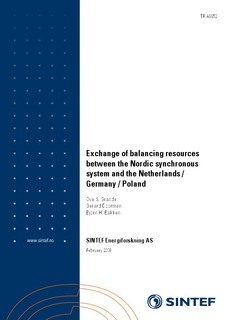| dc.contributor.author | Grande, Ove Steinar | |
| dc.contributor.author | Bakken, Bjørn Harald | |
| dc.date.accessioned | 2017-07-10T09:05:51Z | |
| dc.date.available | 2017-07-10T09:05:51Z | |
| dc.date.created | 2015-09-24T18:43:53Z | |
| dc.date.issued | 2008 | |
| dc.identifier.isbn | 9788259433664 | |
| dc.identifier.uri | http://hdl.handle.net/11250/2448278 | |
| dc.description.abstract | The development and growing integration of power markets and the rapid expansion of new renewable energy sources (RES) with less predictable output, will increase the need for balancing services in the near future. This is the background for the Competence Building (KMB) project “Balance Management”. This initial study provides an overview of the main principles for balance management and the challenges and possibilities related to exchange of reserves between countries and between separate synchronous systems via HVDC-links. The report starts with an introduction to the present practice with regard to balance management in the Nordic and the Northern part of the European Continent. The ongoing process towards Market Coupling between the different day ahead markets in Central Western Europe (CWE) and the Nord Pool area is described as a fundamental background for future integration of the balancing services. So is the Intraday trading, which also will be implemented in all the involved countries in a course of a few years.The use of terminology varies from region to region, reflecting the different properties and history inherited in the different parts of the power system. The main terms regarding imbalances, reserves, control actions and control regions/areas are therefore defined in the report in order to provide a common understanding. Market based solutions for prioritisation of the resources in merit order is used for secondary control in the Nordic system and in the Netherlands, Germany and Poland. The main difference is the technical part where the secondary control on the Continent is based on Automatic Generation Control (AGC) while “manual” control of the “regulation objects” is used in the Nordic countries. Descriptions of the technical aspects, including control of HVDC connections, are presented in Appendix B and C in the report.The present schemes for power exchange between the two separate synchronous systems via HVDC links are described and potential | nb_NO |
| dc.description.abstract | Exchange of balancing resources between the Nordic synchronous system and the Netherlands / Germany / Poland | nb_NO |
| dc.language.iso | eng | nb_NO |
| dc.publisher | SINTEF Energi | nb_NO |
| dc.relation.ispartofseries | SINTEF Energi. Rapport;TR A6652 | |
| dc.rights | Navngivelse-Ikkekommersiell 4.0 Internasjonal | * |
| dc.rights.uri | http://creativecommons.org/licenses/by-nc/4.0/deed.no | * |
| dc.title | Exchange of balancing resources between the Nordic synchronous system and the Netherlands / Germany / Poland | nb_NO |
| dc.title.alternative | Exchange of balancing resources between the Nordic synchronous system and the Netherlands / Germany / Poland | nb_NO |
| dc.type | Research report | nb_NO |
| dc.description.version | publishedVersion | nb_NO |
| dc.rights.holder | SINTEF Energi | nb_NO |
| dc.source.pagenumber | 67 | nb_NO |
| dc.source.issue | TR A6652 | nb_NO |
| dc.identifier.cristin | 1269303 | |
| cristin.unitcode | 7548,50,0,0 | |
| cristin.unitname | Energisystemer | |
| cristin.ispublished | true | |
| cristin.fulltext | original | |

